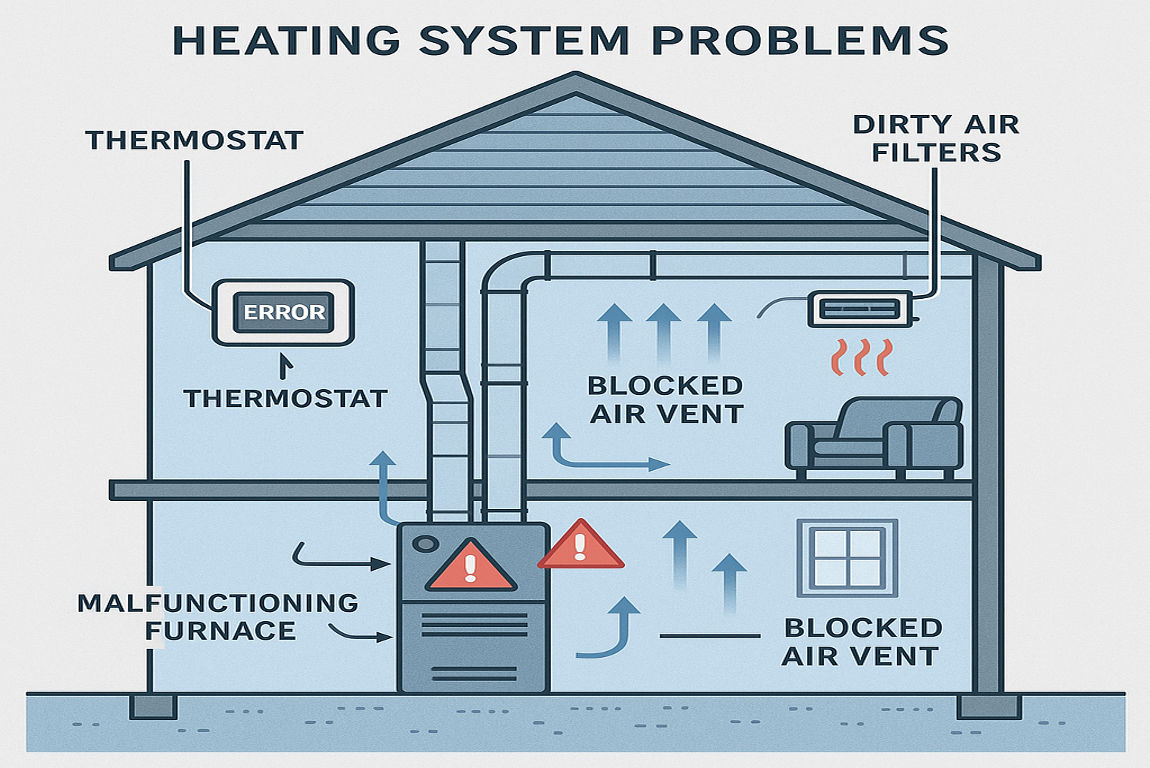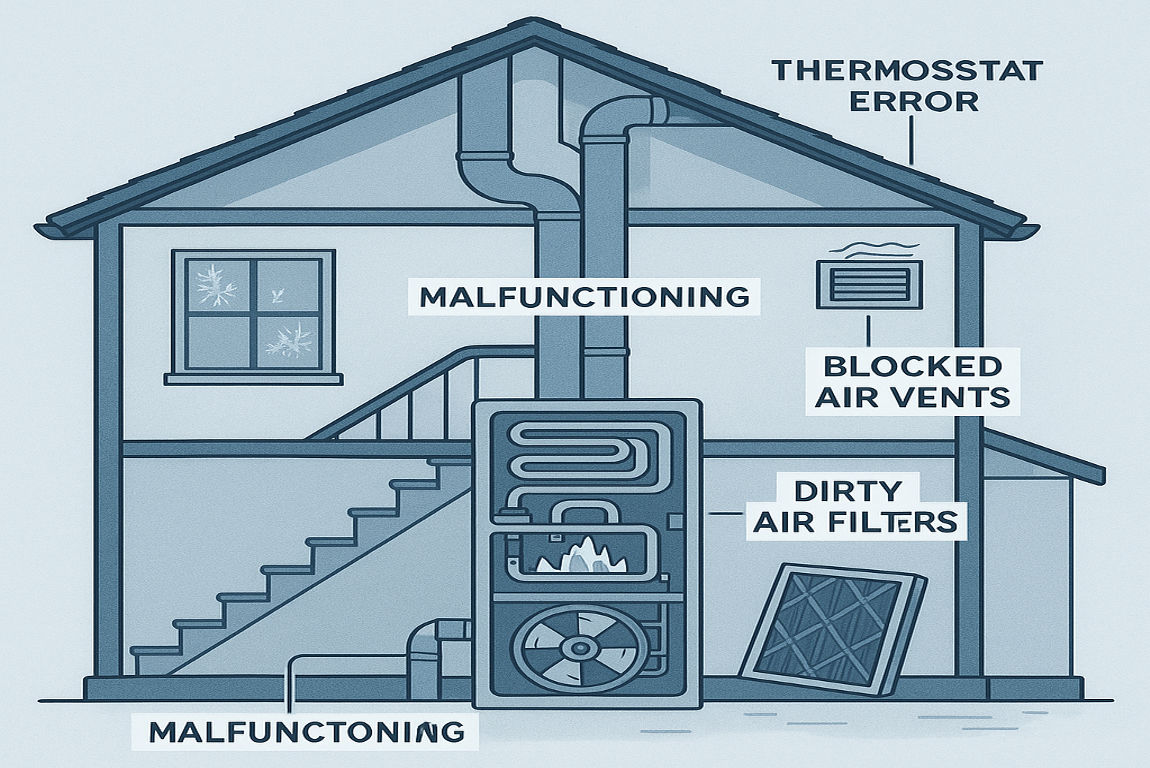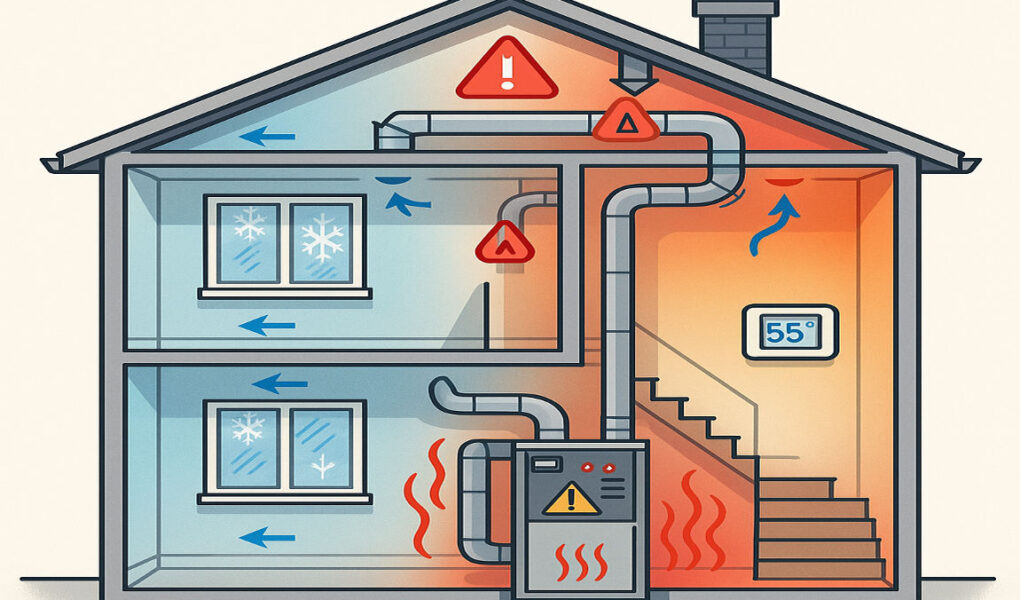When the cold weather sets in, a functioning home heating system becomes essential for comfort and safety. However, many homeowners face the frustrating situation of their heating system failing when they need it the most. If you’ve ever found yourself asking, “Why is the heat not working in my house?” you’re not alone.
Understanding Your Home Heating System

Before diving into troubleshooting, it’s essential to understand the basics of how your home heating system works. This knowledge will help you identify potential issues and address them effectively.
Common Types of Home Heating Systems
There are several types of heating systems commonly used in homes. Here’s a quick overview:
- Furnaces: These are the most common systems in the U.S. They heat air and distribute it through ducts using a blower.
- Heat Pumps: These systems transfer heat from the outside air or ground into your home. They can also work as air conditioners in the summer.
- Radiant Heating: This system uses hot water or electric heating elements to warm floors, walls, or ceilings.
- Electric Heaters: These are standalone units or baseboard heaters that use electricity to generate heat.
Each system has its own set of components and potential issues, which we’ll explore in detail later.
Why Regular Maintenance Matters
Heating systems, like any other appliance, require regular maintenance to function efficiently. Neglecting maintenance can lead to reduced performance, higher energy bills, and unexpected breakdowns. By keeping your system in good shape, you can extend its lifespan and avoid costly repairs.
You may also read (mastering isometric house drawings a complete guidemastering isometric house drawings a complete guide).
Top Reasons Why Heat Is Not Working in Your House

If your heating system isn’t working, there are several potential causes. Let’s break down the most common reasons and how to address them.
Thermostat Issues
The thermostat is the brain of your heating system. If it’s not working correctly, your system won’t function as expected. Here are some common thermostat problems:
- Incorrect Settings: Ensure the thermostat is set to “heat” mode and the temperature is set higher than the current room temperature.
- Dead Batteries: Many thermostats run on batteries. If the batteries are dead, the thermostat won’t work.
- Malfunctioning Thermostat: An old or uncalibrated thermostat can send incorrect signals to your heating system.
How to Fix It: Check the settings, replace the batteries, and consider upgrading to a programmable or smart thermostat for better control.
Power Supply Problems
Your heating system needs power to operate. If there’s an issue with the power supply, the system won’t turn on.
- Tripped Circuit Breakers: Check your electrical panel for tripped breakers and reset them if necessary.
- Power Switch Off: Ensure the power switch on your heating unit is turned on.
- Gas Supply Issues: For gas-powered systems, check if the pilot light is out or if the gas valve is closed.
How to Fix It: Reset circuit breakers, turn on the power switch, and relight the pilot light if needed. Always follow safety precautions when dealing with gas.
Clogged or Dirty Air Filters
Dirty air filters can restrict airflow, causing your heating system to work harder and less efficiently. In some cases, it can even cause the system to shut down.
- Signs of a Dirty Filter: Reduced airflow, uneven heating, or increased energy bills.
- How to Check: Locate the air filter, remove it, and inspect it for dirt and debris.
How to Fix It: Replace the filter with a new one. It’s recommended to change filters every 1-3 months, depending on usage.
Blocked or Closed Vents and Ducts
Blocked vents or ducts can prevent warm air from circulating properly, leading to uneven heating or no heat at all.
- Common Causes: Furniture, rugs, or debris blocking vents.
- Effects: Reduced airflow and increased strain on your heating system.
How to Fix It: Inspect all vents and ducts, remove any obstructions, and ensure they’re fully open.
Wear and Tear / Component Failures
Over time, components in your heating system can wear out or fail. Common issues include:
- Blower Motor Problems: The motor that circulates air can fail, preventing heat distribution.
- Ignition System Issues: Problems with the ignition system can prevent the furnace from starting.
- Pilot Light or Thermocouple Failure: These components are essential for gas-powered systems.
How to Fix It: Component failures often require professional repair or replacement. If you suspect a mechanical issue, it’s best to call an HVAC technician.
Other Causes
Some less common issues include:
- Condensation Pan Overflow: In systems with a condensation pan, a whole pan can trigger a safety switch.
- Air Trapped in Radiators: For radiant heating systems, trapped air can prevent proper heating.
- Insufficient Insulation: Poor insulation can cause heat loss, making it appear as though your system isn’t working.
How to Fix It: Address these issues based on your specific system. For insulation problems, consider consulting a professional.
You may also read (why does my house feel damp when the ac is on).
DIY Troubleshooting Steps for Homeowners

If your heating system isn’t working, there are several steps you can take to troubleshoot the issue before calling a professional.
Check and Adjust Thermostat Settings
- Ensure the thermostat is set to “heat” mode.
- Replace the batteries if needed.
- Reset or recalibrate the thermostat if it’s not responding.
Inspect and Replace Air Filters
- Locate the air filter in your system.
- Remove the filter and inspect it for dirt and debris.
- Replace it with a new filter if it’s dirty.
Ensure Power and Gas Supply Are On
- Check your electrical panel for tripped breakers and reset them as needed.
- Verify that the power switch on your heating unit is turned on.
- For gas systems, ensure the gas valve is open and the pilot light is lit.
Clear and Open Vents and Registers
- Inspect all vents and registers for blockages.
- Remove any obstructions, such as furniture or rugs, from the area.
Bleed Radiators (For Radiant Heating Systems)
- Turn off the heating system and allow the radiators to cool.
- Use a radiator key to release trapped air until water flows steadily.
Reset the Heating System
- Please turn off the system, wait a few minutes, and turn it back on.
- Reset circuit breakers if necessary.
When to Call a Professional HVAC Technician
While DIY fixes can solve many issues, some problems require professional expertise. Here are some situations where you should call an HVAC technician:
- Persistent no heat despite troubleshooting.
- The pilot light won’t stay lit.
- Unusual noises or smells from the system.
- Electrical issues or suspected component failures.
Regular professional maintenance can also prevent future breakdowns and ensure your system operates efficiently.
Preventative Maintenance Tips to Avoid Heating Issues

Preventative maintenance is crucial for keeping your heating system in optimal working condition. Here are some tips:
- Schedule annual professional inspections.
- Replace air filters regularly.
- Keep vents and registers clean and unobstructed to ensure optimal airflow.
- Monitor thermostat performance and replace old units.
- Check for duct leaks or insulation problems.
- Prepare your system before winter arrives.
You may also read (how do you wire a generator to your house).




